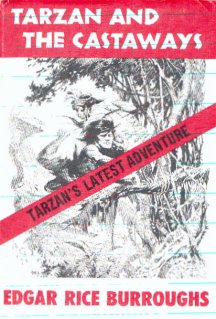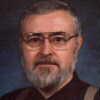
Chattering From The Shoulder
#8
March 31, 2000
By Nkima

![]()
Tarzan and the Castaways
![]()

| The first story in Tarzan and the Castaways is a solid
little Tarzan story beside which the other two in this book are mere bagatelles.
We can't credit or blame Burroughs for this grouping because it was Richard
A. Lupoff who gathered these late stories this way for his Canaveral Press
Edition, 1965. (The stories are: Tarzan
and the Castaways, Tarzan
and the Champion, and Tarzan
and the Jungle Murders.)
Tarzan and the Castaways is a two-part story. The first part takes place on the high seas. It is a tale of prisoners in iron cages on the deck of a ship that reminds one of The Lad and the Lion, but it is a wonderful little story filled with humor. The second part takes place in a lost city of the Mayans in the middle of the South Seas. Here is a chapter summary of the whole. Chapter 1
The wild man is captured and held in a cage for a sea transfer to the animal collector's steamer, the Saigon. Abdullah's dhow is destroyed during the transfer, so he is forced to go to America with Krause and the wild man. Chapter 2
Chapter 3
Chapter 4
Chapter 5
Chapter 6
Chapter 7
Chapter 8
Chapter 9
Chapter 10
Chapter 11
Chapter 12
Chapter 13
Chapter 14
Chapter 15
Chapter 16
Chapter 17
Chapter 18
Chapter 19
Chapter 20
Chapter 21
Chapter 22
Chapter 23
Chapter 24
Note: There is a mysterious Captain Larsen, who is the real captain of the Saigon who is never seen in the story. He lies sick in his cabin. He is either dead or Burroughs forgot about him entirely. Perhaps Tarzan did eat him as suggested in chapter six. (Wolf Larsen wolfed by the Ape-Man.) Commentary Much of this novelette, especially the second half, is written as though it might be a detailed outline for a longer novel. Burroughs had obviously researched the Mayan civilization and culture, but aside from interesting details, he allows the story to run through those old magical rings -- adventurous rounds of abductions and rescues. Burroughs was much better at creating his own lost cities and cultures, and it seems like this adaptation of a real culture blocked some of his inventive powers. The great age of the Mayas lasted from A.D. 300 to 900, and nowhere was it better exemplified than in their glittering ceremonial city of Tikal, at the base of the Yucatan Peninsula. Other centers of the culture were in Palenque, Bonampak, Copan, Uxmal, and Chichen Itza. The cities of Uxmal and Chichen Itza were developed in the Postclassical period after A.D. 900. In the Burroughs story Uxmal was the name of the uncharted island, and the city on this island was named Chichen Itza after the Mayan city in Yucatan. Like other Mayan cities, it featured paved streets and a central stepped pyramid. The Mayans covered their limbs with ornaments of jade, their bodies were richly painted and tattooed, their teeth inlaid with semiprecious stones, and their heads were covered with bonnets of quetzal plumes. Lower class captives became servants and slaves, but captives of higher rank were tortured and killed -- perhaps as part of elaborate religious rites. Perhaps there were even human sacrifices at the alters of the gods. We are not certain that this was so, but certainly succeeding civilizations in Mexico made such offerings an important part of their religion. Archeologists are baffled by the waning of Mayan culture. As with the Olmecs, the Mayas may have experienced a major disaster because the peasants exhausted the land or because they rebelled against their masters. Sometime about A.D. 900 the great Mayan ceremonial centers appear to have been suddenly abandoned though smaller centers continued to exist. In the course of a year, or a decade, or half century, the sumptuous world the Mayas had built became little more than a relic. More information on this topic can be found at http://www.op.net/~uarts/munoz/chichen_itza.html. During the eleventh and twelfth centuries, Chichen Itza was the most sacred city for the Mayans. Chichen Itza had seven major pyramids which featured feathered-serpent columns. There was a pyramid called Temple of the Warriors. It is quite obvious that Burroughs had done his homework when he wrote this story as his descriptions and events surrounding the Mayas ring true. However, he sparingly used the wealth of information available. Perhaps he was using notes and material he had developed in 1934 during the BTE production of his movie The New Adventures of Tarzan filmed in the Guatemalan jungles. Human Sacrifice Despite the tentative note above on humansacrificeamong the Mayans, a look at http://www.op.net/~uarts/munoz/human_sacrifice.html reveals that there were indeed three common practices: The Arrow Sacrifice, The Heart Sacrifice, and The Well Sacrifice, which is employed in the last two chapters of this story. In the Well Sacrifice the victims were bound and thrown into deep natural wells. If the victim was still alive after a certain amount of time, then he or she was rescued. That person was said to have been spared by the gods. Furthermore, that person was believed to have a message from the gods Fortunately, Tarzan was not bound when he was cast into the pool. |
Thor Heyerdahl Thor Heyerdahl, world-renowned Norwegian explorer and archaeologist was born in 1914. He and his bride Liv made their first expedition to Polynesia in 1937-38 where they were adopted by the supreme Polynesian Chief of Tahiti, Teriieroo . During this time, he began to contemplate the existing theories of how the South Pacific inhabitants reached the islands.
http://www4.gve.ch/gci/GreenCrossFamily/board/bios/heyerdahl.html
In 1947 he launched the Kon-Tiki Expedition to demonstrate that the inhabitants of the South Pacific could have come from Peru by sailing a balsa raft across the ocean. He crossed 4300 miles in 101 days and reached Polynesia (Raroia atoll, Tuamotu Archipelago.) Tarzan and the Castaways was written in November of 1940, so he anticipated Heyerdahl's voyage by seven years. Heyerdahl had actually first published his theory of Polynesian migration in "International Science," New York in 1941, so unless he had talked to Heyerdahl himself, he anticipated even the theory.
Beebe,Charles William (1877-1962)
Col. William Cecil Hugh Percival Leigh's fascination with Beebe mentioned in chapter seven refers to the indefatigable American explorer and naturalist who wrote over 300 articles and books, among which were: "Jungle Days" (1925) "Beneath Tropic Seas" (1928) and "Half Mile Down" (1943).
http://www.fwkc.com/encyclopedia/low/articles/b/b003000807f.html
Tarzan and the Valley of Gold starring Mike Henry (1966)
Tangentially related because of Tarzan's adventures with New World jungle cultures, this American International movie was released in May 1966 with a novel adaptation by Fritz Leiber in the same year. It takes place in Mexico and the jungles of Brazil in the haunts of an ancient Incan city.(All of my film notes were found in David Fury's Kings of the Jungle, McFarland, 1994.)
Tarzan of the Apes, starring Elmo Lincoln (1918)
Parts of this film were shot in the jungle of Brazil (as well as on location in Louisiana.)
The New Adventures of Tarzan, starring Herman Brix (1935) One of the most interesting of all Tarzan productions, it was filmed in the Guatemalan jungles. This was made by the Burroughs-Tarzan Enterprises (BTE) composed of Ashton Dearholt*, George Stout, and Ben Cohen, "promoters" and ERB, "owner." ERB himself roughed out an original story for this new Tarzan picture.
The film crew met with tropical storms, rugged jungles, and angry Guatemalan Indians. Locations included the Mayan ruins at Tikal and Guatemala City. Eventually the whole convoluted mishmash was reedited into a second feature, "Tarzan and the Green Goddess," which was released in 1938.
You can read the whole story in David Fury's excellent book.
 *By 1934 Ed and Emma were separated and he continued to spend his time with Florence (Ashton Dearholt's former wife) and her relatives and friends. Their divorce followed on December 6, 1934 in Las Vegas. Ed married Florence Dearholt on April 4, 1935.
*By 1934 Ed and Emma were separated and he continued to spend his time with Florence (Ashton Dearholt's former wife) and her relatives and friends. Their divorce followed on December 6, 1934 in Las Vegas. Ed married Florence Dearholt on April 4, 1935.
Tarzan and the Great River, starring Mike Henry (1967)
Filmed in Brazil, the story takes place in South America.Tarzan and the Jungle Boy, starring Mike Henry (1968)
Filmed in Brazil, although the story takes place in Africa.
The Quest of Tarzan
The first publication of Tarzan and the Castaways was under the title of "The Quest of Tarzan" in Argosy Weekly, August 23, 30; September 6, 1941. Mike Conran reprinted this first magazine appearance as a free supplement to issue #34 of the fanzine Edgar Rice Burroughs News Dateline, May 1989. The editor, Michael Conran, provides an interesting but brief analysis of the changes the Argosy editor made to ERB's original manuscript, and a summary of the differences between the first edition and the 1975 reprint by Canaveral Press. (ERB: The Exhaustive Scholar's and Collector's Descriptive Bibliography by Robert B. Zeuschner)
The End
Quaesitum Dementis Hominum
(A Retelling of Tarzan and the Castaways)
by NkimaA wild man is in an iron cage on the rolling deck of a leaking tub. He is eating raw meat like a lion. He is quite mad.
Next to his cage is another cage full of beautiful women who are longing to be thrust into the wild man's clutches.
Next to this cage is another cage full of snotty Englishmen and Englishwomen who make snide comments.
Below the decks there are orangutans, elephants, lions and tigers, snakes, and an odd assortment of other beasts.
The ship is being run by another madman who trusses up Chinamen and has them whipped in front of the cages.
Swarthy Lascars swarm over the decks with sharpened stakes that they poke at the caged ones.
Soon there is a mutiny and the wild man takes firm control of the women.
They are all shipwrecked on an uncharted island in the South Seas inhabited by ancient Mayans who practice human sacrifice as part of their national religion.
The wild man releases the animals from below deck, then kills a lion because it wants to eat a Mayan.
The women run around naked with the naked wild man, which causes more comment.
The wild man kills his former tormentors and a few stray Mayans who cross his path.
The Mayan priests throw the wild man into a volcano full of water, but he swims long enough to reform their religion and ride into the sunset on an elephant.
The women want to go with the wild man-man but he is promised to another.
Only the orangutans are sane.
The End



David Adams
Nkima and his friend, David Adams, would like to hear from ERB fans
davidadams@willmar.comVisit
ERBzine 0396:
for a complete list of Nkima's other
Chattering From The Shoulder columns
![]()
![]()
![]()
Volume
0309

BILL
HILLMAN
Visit
our thousands of other sites at:
BILL
& SUE-ON HILLMAN ECLECTIC STUDIO
ERB
Text, ERB Images and Tarzan® are ©Edgar Rice Burroughs, Inc.-
All Rights Reserved.
All
Original Work ©1996-2004 by Bill Hillman and/or Contributing Authors/Owners
No
part of this web site may be reproduced without permission from the respective
owners.